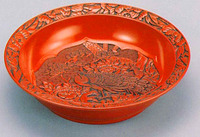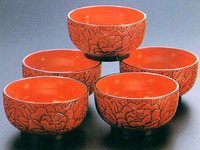

Total:131items
- Pottery & Porcelain (18)
- Lacquerware (4)
- Glasswork (2)
- Wood & Bamboo Work (19)
- Leather Work (1)
- Papermaking (13)
- Textile (20)
- Dyeing products (5)
- Masonry (1)
- Metal Work (11)
- Stationery (4)
- Livingware (3)
- Accessory (4)
- Toys & Entertainment (14)
- Interior (2)
- Other crafts (10)

 |
Main Production Site:Miyagi |
 《Characteristics》
《Characteristics》Tuishu is referred to as one of the techniques called 'choshitsu' in lacquerware manufacturing that repeatedly applies thick vermilion-colored lacquer on the ware, on which design patterns are later engraved. Choshitsu also includes application of other colors such as tsuikoku and tsuio that use black and yellow lacquer respectively.
The techniques originated in China and reportedly have been introduced into Japan around the Kamakura and Muromachi periods (13-16C.). Lacquerware manufactured with the techniques, by engraving on the base and finishing with vermilion lacquer, is called 'tsuishu' in Japan.
The tsuishu manufacturing techniques were brought into Miyagi Prefecture at the end of the Meiji period by Einojo Kawasaki, a master of Murakami Tsuishu lacquerware in Niigata Prefecture. He was invited to the Miyagi Prison to teach the techniques, which prevailed across the area and was later founded as one for Sendai-Tsuishu excellent in heat and water resistance. Embossing method developed for efficient base engraving is one of the features of Sendai-Tsuishu manufacturing techniques.
Senda-Tsuishu is lacquerware that offers unique warmness and elegance created by wood carving and yet toughness and usefulness, characterized by glossy vermilion lacquer with plump thickness and careful and elaborate manufacturing processes from wood carving through polishing to coating,
Sendai-Tsuishu lacquerware that has evolved with a-century tradition combines its classical taste with modern taste and has been cherished as souvenirs and gifts by local people.
[Designated by the governor of Miyagi Prefecture as a traditional craft]
Information provided by Sendai Tsuishu Seisakujo
Translation by: Tomoko Yamamoto

| Materials | Wood, lacquer, etc. |
|---|---|
| Crafting Processes | [1]Carving
Wooden base is created for prototype, followed by hand-carving of design patterns such as flowers and birds. Embossing method is applied for mass production. [2]Lacquer coating Lacquer is applied on carved wooden base. Not too thick, not too thin -lacquer work is finished with careful lacquer coating. |
| History | Sendai-Tsuishu manufacturing dates back to the end of the Meiji period (early 20th century), long time after the production of lacquerware under the ruling of Date domain disappeared. Tradition says that Murakami-Tsuishu craftsman Kawasaki Einojo came to Sendai from Niigata Prefecture and founded the base for Sendai-Tsuishu.
Kawasaki established lacquerware called "Touka-tsuishu" that employs a unique manufacturing method to cover the wood base with fine relief made by mold making. He achieved mass-production method of tsuishu lacquer work, consequently contributing to the prevalence of reasonable, tough, and easy-to-use lacquerware among ordinary people. Later, when tsuishu lacquerware manufacturing declined, a man named Tadashi Minami succeeded the techniques as one for Sendai Tsuishu. Minami was a master of maki-e (decorated lacquerware produced by sprinkling wet lacquer with metallic powder, usually gold or silver on it) and had close relationship with Einojo Kawasaki through working for an institute for industrial arts. He established Sendai Tsuishu Seisakusho after World War II, which has survived to date as the only studio that produces Sendai Tsuishu lacquerware with the inherited traditional techniques for generations over a century. |
| Related URL | http://www.tsuishu.net/index.html |
◆Exhibition / Showcase
Sendai Tsuishu Seisakusho (Japanese Only)
*Shop and workshop are scheduled to move on March 23, 2015. Contact the company in advance for your visit.
Assistance needed? For inquiries in English:
JTCO Contact Form
Your inquiries will be forwarded by JTCO in Japanese to the organization you wish to contact.



